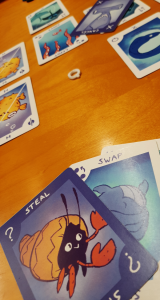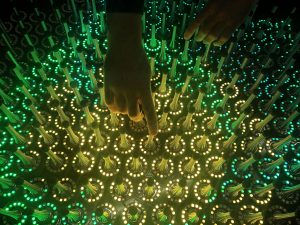
Author PhD Matteo Rossi
TCSM Postdoctoral Researcher
Turku Quantum Technologies group
This post is about one aspect of our job as scientists that we often tend to neglect or avoid as much as possible but plays a very important role towards the society: outreach. Outreach is a challenging task, as it requires us to rethink our everyday work from the perspective of someone completely new to the topic, to communicate the relevance of your research engagingly, to explain in a few minutes concepts that you learned in years of studies and training.
Some topics are particularly challenging, as they are so far from common experience. With these, the hardest part is to find a way to give an intuitive description of the phenomena that happen, and this is exactly the case I’ve been facing in explaining quantum mechanics.
Quantum mechanics was formulated a century ago to explain the physics of the microscopic constituents of matters, such as atoms, molecules or photons. While it is a clear, sound mathematical construction, that can predict experimental results with high accuracy, it is well known for being a difficult topic to understand.
The reason is in the fact that the phenomena it predicts completely defy our intuition. Electrons can be in a superposition state (for example, they can be in two locations at the same time), and the action of observing them will make their state collapse to a particular state; two atoms interacting between them can become entangled, and observing one of them will affect the other one, even if they are very far apart.
But we cannot grasp these concepts, because quantum mechanics is hidden from our everyday experience: we evolved in a world where cats are not dead and alive at the same time, and the moon is in that specific position whether we look at it or not. While everyone has direct experience of gravity and its (sometimes painful) consequences, no one can see an electron or a photon, or interact with it.
Even if we don’t yet fully understand it, we used quantum mechanics to achieve impressive technological results: we use transistors in all our electronic devices and lasers, etc. In the last decades, we have been able to isolate, control and observe individual quantum systems, and this has brought about the possibility of a new set of technologies, in what we call the second quantum revolution.
The most popular of these quantum technologies is the quantum computer. By using quantum superposition and entanglement, it can solve certain calculations much faster than traditional computers. Its potential is so groundbreaking that governments all over the world, many startups (also here in Finland) and big tech corporations (IBM, Google, Microsoft, …) are investing billions of dollars in the quest to develop the first quantum computer that beats a traditional supercomputer.
Explaining the potential of quantum technologies and how they can be used in the future is very important, as they have the potential to be disruptive in the next years, and yet it is very challenging, as it requires communicating something that is far from being intuitive.
When I joined the Turku Quantum Technologies group more than two years ago, I’ve been thrown into the myriad outreach activities organized by professor Sabrina Maniscalco. In the beginning, it was quite stressful for me, as it is something I haven’t really practiced during my PhD, but it soon became quite a fun activity! Beside the traditional outreach means like public lectures at schools, libraries, etc., we have been exploring different ways of teaching the basic ideas of quantum physics to the general public, and we have focused in particular on using arts and videogames as media to engage people of different ages and to help them form an intuition of concepts like superposition and entanglement.

Q|Cards>
Of course, this hasn’t been an easy task, as we need to communicate the concepts to the artists/game designers themselves, to develop a common language and to brainstorm ideas. To help this challenging process, we have organized several workshops and game jams, where physicists, game artists, and developers have a weekend to develop quantum-themed games. The last one, Quantum Wheel, held last year in Helsinki, was a success, with developers from Rovio and Supercell.
One of the games designed at the Quantum Wheel, called Q|Cards>, was so nice that we decided to develop it further as an educational game. It is a card game in which the players need to program a quantum computer so that it outputs their desired output. By thinking about possible winning strategies, they develop an understanding of how quantum programming works (and it is quite different than standard computer programs!). Helped by MiTale, a Turku-based game company, we developed the card game and a companion mobile app to run the programs on a simulator or on an actual prototype IBM quantum computer.

Quantum Garden
With London-based game artist Robin Baumgarten we realized the Quantum Garden, an interactive installation that gives a beautiful visualization of dynamics of a quantum particle on a big board with LEDs and springs. The piece has received a lot of attention, and it has been exhibited in different locations in Finland and worldwide. We now plan on building a much larger version to be exhibited in museums and galleries.
These are a few examples of the various activities I’ve been collaborating on, and more information is available on the QPlay project website. During this period as a TCSM postdoctoral researcher I have realized that how public engagement and outreach are challenging, but fun activities, as they stimulate your creativity by forcing you to think about your research problem from a different perspective. And you might learn more about your field. As (probably) Albert Einstein put it: “You don’t really understand something unless you can explain it to your grandmother”.
Matteo Rossi
TCSM Postdoctoral Researcher
Department of Physics and Astronomy
Turku Quantum Technologies group
